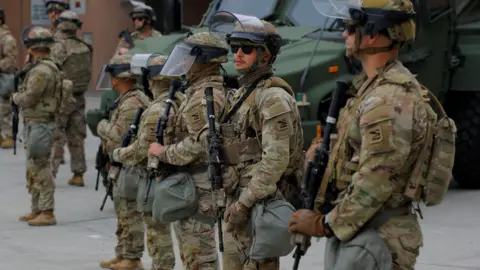The recent events in Los Angeles have stirred notable reactions in the political landscape, particularly regarding President Donald Trump’s swift intervention during protests aimed at Immigration and Customs Enforcement (ICE) operations. This decisive action was portrayed by the Trump administration as a necessary measure to uphold law and order, catering to sentiments that resonate deeply with his political base. As protests erupted in response to ICE activities, Trump asserted his stance against what he refers to as left-wing lawlessness, claiming that he would deploy federal resources to manage the situation effectively.
The Los Angeles Police Department (LAPD) reported that the protests were predominantly peaceful, with only a small fraction of participants engaged in disruptive behavior. This report contrasts sharply with the Trump administration’s narrative that immigration officers were endangered by the protests, prompting a need for urgent federal intervention. As tensions escalated, Homeland Security Secretary Kirsty Noem criticized local law enforcement’s response time, emphasizing the urgency required during what she labeled violent protests.
Following the decision to federalize the California National Guard, which involved around 2,000 troops, Defense Secretary Pete Hegseth indicated that the U.S. Marines were on “high alert” for potential deployment as well. This move marks a significant step in federal military involvement in domestic situations, a rarity in American history, and has raised questions and objections from various sectors, including California Governor Gavin Newsom, who opposed the federalization of the National Guard troops.
On Sunday morning, Trump declared an early victory, crediting the National Guard’s presence for restoring peace in Los Angeles, despite the fact that the troops were still in the process of being mobilized. The administration’s swift reaction underscores a narrative that positions strong immigration enforcement and a commitment to maintaining public order as pivotal elements of Trump’s platform. This approach aims to solidify support from his base and potentially appeal to political independents who may prioritize safety and security in their voting decisions.
Trump’s stance is part of a broader strategy that emphasizes strict enforcement of immigration laws, a point echoed by Noem, who highlighted the administration’s intent to prevent a repeat of the civil unrest seen in 2020 during the Black Lives Matter protests. Her assertion that the current administration would take a firmer approach reflects an overarching theme within Trump’s policy framework.
However, Democrats have voiced substantial criticism regarding the administration’s militaristic approach to domestic protests. They argue that actions such as deploying federal agents in military gear to arrest civilians have escalated tensions and could lead to further unrest rather than quelling it. Senator Cory Booker of New Jersey articulated concerns that these measures, especially when unrequested, break with longstanding traditions and may inadvertently incite more conflict.
As early June unfolds, America finds itself at a critical juncture with historical precedence for summer protests. The unrest surrounding immigration enforcement in Los Angeles could either represent a unique moment in a series of events or foreshadow a broader wave of civil unrest looming on the horizon. With months of summer still ahead and the political implications of Trump’s approach in play, the evolving dynamic will likely continue to attract national attention and could influence campaign strategies as the next election cycle draws nearer.
In summary, Trump’s decisive action in deploying National Guard troops to address protests in Los Angeles reflects a calculated political maneuver designed to rally his base and project strength in governance. Nonetheless, it poses a risk of escalating tensions and may provoke a counter-response from those advocating for civil liberties and a more measured approach to immigration enforcement. The ramifications of these events will shape political discourse and public sentiment in the months to come as America navigates its complex social landscape.



